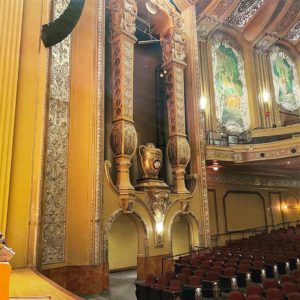
I remember that when I first arrived in Milwaukee in January of 1988, I went to the Milwaukee Symphony Orchestra offices. They were located in the office building above an old movie theater, in a part of downtown that could have used a little sprucing up. Thirty-three years later, the MSO offices are back in the same building above the theater, but everything else is different.
The 1931 art deco building was the Warner Grand Theater until 1995. Rapp & Rapp of Chicago, an architectural firm responsible for many other movie palaces subsequently converted to concert halls in such places as Indianapolis, St. Louis, and Pittsburgh, delivered a mixture of Beaux Arts, rococo, and baroque decor, at a cost of almost $50 million (in 2020 dollars).
The project to turn it into a symphony hall had been about twenty years in the making. In the year 2000, the orchestra did an acoustical test at the Grand Theater, using a temporary stage. We were thrilled at the clarity and warmth. Then we put it all aside for an awfully long time, due to lack of interest from donors and city government, which would need to narrow the street behind the hall to make room for a stage and backstage facilities.
In recent years, however, major donors and the city both came to realize that converting the old movie palace into a modern concert hall was a win-win for everyone. Our management and board made a convincing case that control of our own venue—sorely lacking in our previous county-owned “home”—was essential to the MSO’s survival, while the city came to see that the area immediately around the theater desperately needed a spark to ignite renovation and development of the center of downtown.

Photo credit: Ilana Setapen
Renovation began in 2018, and went smoothly, including moving a 625-ton wall 35 feet—in one piece—as required to qualify for $15 million in historic preservation credits. Fast forward to 2020, we were not able to open the new hall as we had planned, because of COVID-19 and a downtown steam tunnel flood that destroyed new electric equipment in our basement. We had last performed in mid-March 2020, and management waited until the fall of 2020 to negotiate a pandemic agreement. Our first masked and distanced chamber music concerts began at the new Bradley Symphony Center in early February, for a virtual audience only. “When I walked on stage for the first rehearsal in our new hall, my jaw literally dropped,” said Robert Levine, MSO violist and Local 8 president. “The hall looked brand-new; all of the gorgeous French Renaissance murals had been painstakingly restored and just glowed. The stage was visually very warm and welcoming. And the first words out of my mouth reverberated throughout the entire space. It’s only the second or third time in my life that I’ve fallen in love with a hall at first sight and sound.”
In-person audiences returned to MSO performances in April, and at this point the plan is to continue to limit the audience to 150 people for the remainder of this season. Some of the features we’ll all eventually be enjoying:
- We preserved as much of the original opulent decor as possible, because its uneven surfaces reflect sound better than flat surfaces.
- A new two-story lobby and event space, enclosed with floor-to-ceiling glass, fronts the main street downtown.
- Our state-of-the-art HVAC system is mounted on springs to prevent vibration and sound from reaching musicians and audience. We are still in the process of tweaking and configuring the control system that will help keep us comfortable through changing seasons.
- Our plasma air bipolar ionization system deactivates virus particles by emitting negative charges into the air. The charges (ions) attach themselves to particles like viruses, which get weighted down, and either get caught up in filters, or fall from the airstream and perish because they can’t replicate. We have monitoring equipment on backorder, which will tell us how we’re doing with distributing the ions.
- Our catering kitchen has the most top-shelf appliances available, and will be able to serve the most demanding menus and quantities.
- We once again have office space in the tower above the theater. From the lower level to the 6th floor, we also have event space, music libraries, choral warmup space, and meeting rooms. Floors 7–12 are not yet developed, awaiting future demands that will determine their function.
Local 8 had originally planned to host the 2021 ICSOM Conference, and we had been looking forward to showing our new hall to all the delegates, officers, and guests. I’m sure you all know that we won’t be doing that this year, but we look forward to seeing everyone as soon as it’s our turn!
Note: the author is the ICSOM delegate for the Milwaukee Symphony Orchestra





